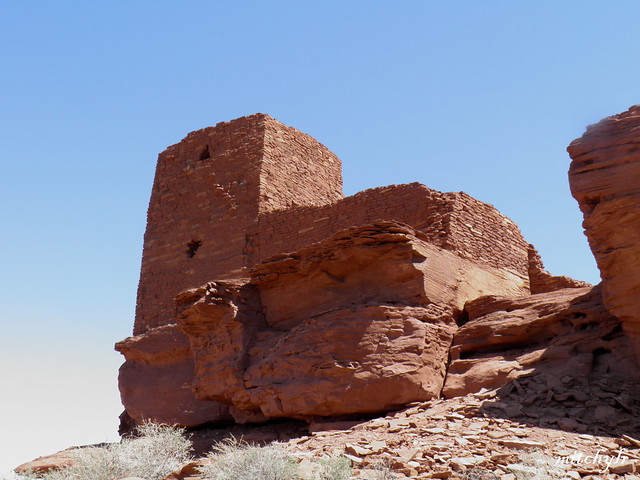Another set from my trip to Arizona with Joanne back in April. Just like Montezuma's Castle National Monument, this was not originally on our list of places to visit, but as it was just to the north of the Sunset Volcano (which was on our list), we decided to take both in on the same day.
Located to the north of Flagstaff, Wupatki is an important site of Native American ruins. The settlements were built by the ancient Pueblo peoples, notably the Sinagua, Cohonina and Kayenta Anasazi.
Wupatki, in the Hopi language, means 'Tall House', and is given to the largest structure within the National Monument, containing over 100 rooms (see above). The second largest structure, located several miles away, is Wukoki. In shape, it resembles a traditional European castle, but like all the buildings here, is made out of thin, flat blocks of local sandstone. In fact it blends in so well, it almost appears to have grown out of the sandstone mesa it stands on.
Although populated from as early as 500AD, the major population movement into this area occurred in the 11th century following the eruption of the nearby Sunset Volcano, which covered the area in volcanic ash, improving the local soil's productivity greatly.
At it's height, around 2000 people lived in the various settlements within the area marked today by the National Monument boundary (an area of approx 35,000 acres). As well as the larger settlements, there were smaller ones scattered between them, including some box-canyon dwellings.
Eventually, the semi-nomadic peoples moved on, and by approx 1225, the settlements were largely abandoned. Although today it appears that the settlements are abandoned, they are still respected and cared for by the Hopi people.
The rest of this set can be seen in this Flickr slideshow:





Mmmm, wonderful thing to have seen, Mitch. Some fascinating shots there too. As you say, the buildings do seem to rise directly out of the rock. It's interesting that the volcano ash will indeed have made the area more fertile, but it all looks pretty barren now.
ReplyDeleteThanks Neil. That shot of the road is actually looking away from the reservation towards the Painted Desert (barely discernable in the distance). Within the area of the National Monument, there are areas that have reverted back to typical Arizonan desert, but there are also large areas that are grassland, having obviously retained some of the fertility of the volcanic ash.
DeleteThese are awesome mate a wonderful adventure you had absolutely amazing;)
ReplyDeleteThanks Baz. It was great!!
DeleteI enjoyed this post Mitch-thanks
ReplyDeleteThanks for looking, Kathy :-))
DeleteAmazing how they piled those stones together and they still remain together today. That must have been an interesting excursion.
ReplyDeleteYes, they were exceptional builders for their time, given such limited resources. It certainly was interesting :-))
DeleteLove the photos. I have not seen this area. Want to one of these days.
ReplyDeleteThanks Lynda. I hope you get the chance, it's a beautiful place.
DeleteVery interesting post with beautiful photos and the slideshow gave me the illusion that I had been there too....
ReplyDeleteThanks for looking, Belita. I'm glad you enjoyed it :-))
Delete...it is as beautiful as it is fascinating! Just imagine how long it took to build those and how labor intensive it must have been.
ReplyDeleteI really admire the Native American people for their respect of the earth and of their ancestors.
Thanks Danette. It's even more amazing when you consider how small the population was over the entire area in those times.
DeleteI feel the different energy just by looking at your slideshow, I like old things old...
ReplyDeleteI especially like few shots of the road reaching nowhere in a lonely plain.
And look! another bird posed for you, even at Wupatki! :)
Thanks Sophie. There is a special feeling standing amongst these ruins.
DeleteYes, one lonely bird followed us for a while. Maybe he thought we might feed him. Unfortunately, we had no food for him.